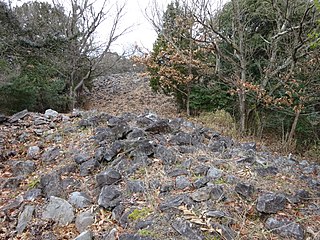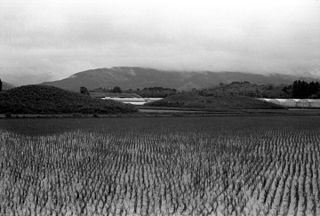
Kofun are megalithic tombs or tumuli in Northeast Asia. Kofun were mainly constructed in the Japanese archipelago between the middle of the 3rd century to the early 7th century CE.

Furuichi kofungun (古市古墳群) is a group of Kofun period burial mounds located in the cities of Fujiidera and Habikino, Osaka Prefecture, Japan. Twelve of the tumuli in this group were individually designated a National Historic Site of Japan in 1956, within additional 14 collectively added to the designation in 2001, and the area under protection expanded in 2018.

The Rokuroseyama Kofun Cluster is a group kofun burial mounds located in the Maruoka neighborhood of the city of Sakai, Fukui in the Hokuriku region of Japan. The site was designated a National Historic Site of Japan in 1990.

The Sakuradani Kofun Cluster is a group of kofun burial mounds located in the Ōta neighborhood of the city of Takaoka, Toyama in the Hokuriku region of Japan. Two of the tumuli were designated as a National Historic Site of Japan in 1934.

The Kannondaira-Tenjindō Kofun cluster is an archaeological site containing two separate groups of early to middle Kofun period burial tumulii located in what is now part of the city of Myōkō, Niigata in the Hokuriku region of Japan. The site was designated a National Historic Site of Japan in 1978.

The Ōyasuba Kofun cluster is a group of five early to middle Kofun period megalithic tumuli located in what is now part of the town of Kōriyama, Fukushima in the southern Tōhoku region of Japan. The largest of the tumuli at the site was designated a National Historic Site of Japan in 2000.

The Amenomiya Kofun Group is a group of middle Kofun period burial tumuli located in the Rokusei neighborhood of the town of Nakanoto, Ishikawa in the Hokuriku region of Japan. The site was designated a National Historic Site of Japan in 1982.

Ōmuro Kofun Group is a group of late Kofun period burial mounds located in the Matsushiro neighborhood of the city of Nagano in the Chubu region of Japan. The site was collectively designated a National Historic Site of Japan in 1997.

The Hodota Kofun Cluster (保渡田古墳群) is a group of three Kofun period burial mounds located in what is now the city of Takasaki, Gunma Prefecture in the northern Kantō region of Japan. It was designated a National Historic Site of Japan in 1985.

Funakiyama Kofun group is a cluster of Kofun period burial mounds located the city of Motosu, Gifu Prefecture in the Chūbu region of Japan. It was designated a National Historic Site of Japan in 2018.

The Arioka Kofun Cluster is a group of kofun burial mounds located in the city of Zentsūji, Kagawa Prefecture, on the island of Shikoku of Japan. The tumuli were collectively designated a National Historic Site in 1984. It is claimed to be a group of tombs of the powerful local family who were the ancestors of the famed prelate Kūkai.

The Mihata Kofun Cluster (美旗古墳群) is a group of Kofun period burial mounds located in the Mihata neighborhood of the city of Nabari, Mie in the Kansai region of Japan. It was designated a National Historic Site of Japan in 1978. It is the largest group of kofun in the Iga region.
The Kasugayama Kofun Cluster (春日山古墳群) is a group of Kofun to early Nara period burial mound located between the Manotaniguchi neighborhood of the city of Ōtsu, Shiga in the Kansai region of Japan. A portion of this tumuli cluster was designated a National Historic Site of Japan in 1974.
The Kohori Kofun Cluster (古保利古墳群) is a group of Kofun to early Nara period burial mound located in the Takatsuki neighborhood of the city of Nagahama, Shiga Prefecture in the Kansai region of Japan. It was designated a National Historic Site of Japan in 2003. It is the largest kofun cluster in Shiga Prefecture.

The Naruto Itano Kofun cluster is a group of nine kofun burial mounds located between the city of Naruto and Itano, Tokushima Prefecture, on the island of Shikoku, Japan. The tumuli were collectively designated a National Historic Site in 2016.

The Iwaseoyama Kofun Cluster is a group of Kofun period burial mounds located on the Iwaseo mountains spreading across the Mineyama, Muromachi, Miyawaki, Nishikasuga, Tsuruichi, and Nishitakara neighborhoods of the city of Takamatsu, Kagawa Prefecture on the island of Shikoku Japan. The cluster was designated a National Historic Site in 1934, with the era under protection expanded in 1985 and 1989..

The Miwayama Kofun cluster is a group of kofun burial mounds located in Ninomiya neighborhood of the city of Tsuyama, Okayama Prefecture, in the San'yō region of Japan. The tumuli were collectively designated a National Historic Site in 2015.
The Nakaoda Kofun Cluster is a group of Kofun period burial mounds located in the Kuchida-minami neighborhood of Asakita Ward in the city of Hiroshima, in the San'yō region of Japan. The cluster was designated a National Historic Site in 1996.

Kawaminami Kofun Cluster (川南古墳群) is a group Kofun period burial mounds, located in the Nishibeppu neighborhood of the town of Kawaminami, Miyazaki on the island of Kyushu Japan. The tumulus cluster was collectively designated a National Historic Site of Japan in 1961.
The Minamikata Kofun cluster (南方古墳群) is a group of Kofun period burial mounds located in the Amori-cho, Yoshino-cho, Onuki-cho, Maino-cho, Noji-cho neighborhoods of the city of Nobeoka, Miyazaki Prefecture in Kyushu Japan. The tumulus group was collectively designated a National Historic Site of Japan in 1943.


















